| Star formation |
|---|
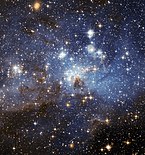 |
| Object classes |
| Theoretical concepts |
Young stellar object (YSO) denotes a star in its early stage of evolution. This class consists of two groups of objects: protostars and pre-main-sequence stars.
| Star formation |
|---|
 |
| Object classes |
| Theoretical concepts |
Young stellar object (YSO) denotes a star in its early stage of evolution. This class consists of two groups of objects: protostars and pre-main-sequence stars.
A star forms by accumulation of material that falls in to a protostar from a circumstellar disk or envelope. Material in the disk is cooler than the surface of the protostar, so it radiates at longer wavelengths of light producing excess infrared emission. As material in the disk is depleted, the infrared excess decreases. Thus, YSOs are usually classified into evolutionary stages based on the slope of their spectral energy distribution in the mid-infrared, using a scheme introduced by Lada (1987). He proposed three classes (I, II and III), based on the values of intervals of spectral index : [1]
.
Here is wavelength, and is flux density.
The is calculated in the wavelength interval of 2.2–20 (near- and mid-infrared region). Andre et al. (1993) discovered a class 0: objects with strong submillimeter emission, but very faint at . [2] Greene et al. (1994) added a fifth class of "flat spectrum" sources. [3]
This classification schema roughly reflects evolutionary sequence. It is believed that most deeply embedded Class 0 sources evolve towards Class I stage, dissipating their circumstellar envelopes. Eventually they become optically visible on the stellar birthline as pre-main-sequence stars.
Class II objects have circumstellar disks and correspond roughly to classical T Tauri stars, while Class III stars have lost their disks and correspond approximately to weak-line T Tauri stars. An intermediate stage where disks can only be detected at longer wavelengths (e.g., at ) are known as transition-disk objects.
YSOs are also associated with early star evolution phenomena: jets and bipolar outflows, masers, buHerbig–Haro objects, and protoplanetary disks (circumstellar disks or proplyds).

These stars may be differentiated by mass: Massive YSOs, intermediate-mass YSOs, and brown dwarfs.

Star formation is the process by which dense regions within molecular clouds in interstellar space, sometimes referred to as "stellar nurseries" or "star-forming regions", collapse and form stars. As a branch of astronomy, star formation includes the study of the interstellar medium (ISM) and giant molecular clouds (GMC) as precursors to the star formation process, and the study of protostars and young stellar objects as its immediate products. It is closely related to planet formation, another branch of astronomy. Star formation theory, as well as accounting for the formation of a single star, must also account for the statistics of binary stars and the initial mass function. Most stars do not form in isolation but as part of a group of stars referred as star clusters or stellar associations.

Luminosity is an absolute measure of radiated electromagnetic energy (light) per unit time, and is synonymous with the radiant power emitted by a light-emitting object. In astronomy, luminosity is the total amount of electromagnetic energy emitted per unit of time by a star, galaxy, or other astronomical objects.

Angular resolution describes the ability of any image-forming device such as an optical or radio telescope, a microscope, a camera, or an eye, to distinguish small details of an object, thereby making it a major determinant of image resolution. It is used in optics applied to light waves, in antenna theory applied to radio waves, and in acoustics applied to sound waves. The colloquial use of the term "resolution" sometimes causes confusion; when an optical system is said to have a high resolution or high angular resolution, it means that the perceived distance, or actual angular distance, between resolved neighboring objects is small. The value that quantifies this property, θ, which is given by the Rayleigh criterion, is low for a system with a high resolution. The closely related term spatial resolution refers to the precision of a measurement with respect to space, which is directly connected to angular resolution in imaging instruments. The Rayleigh criterion shows that the minimum angular spread that can be resolved by an image forming system is limited by diffraction to the ratio of the wavelength of the waves to the aperture width. For this reason, high resolution imaging systems such as astronomical telescopes, long distance telephoto camera lenses and radio telescopes have large apertures.

A protostar is a very young star that is still gathering mass from its parent molecular cloud. It is the earliest phase in the process of stellar evolution. For a low-mass star, it lasts about 500,000 years. The phase begins when a molecular cloud fragment first collapses under the force of self-gravity and an opaque, pressure-supported core forms inside the collapsing fragment. It ends when the infalling gas is depleted, leaving a pre-main-sequence star, which contracts to later become a main-sequence star at the onset of hydrogen fusion producing helium.

Herbig–Haro (HH) objects are bright patches of nebulosity associated with newborn stars. They are formed when narrow jets of partially ionised gas ejected by stars collide with nearby clouds of gas and dust at several hundred kilometres per second. Herbig–Haro objects are commonly found in star-forming regions, and several are often seen around a single star, aligned with its rotational axis. Most of them lie within about one parsec of the source, although some have been observed several parsecs away. HH objects are transient phenomena that last around a few tens of thousands of years. They can change visibly over timescales of a few years as they move rapidly away from their parent star into the gas clouds of interstellar space. Hubble Space Telescope observations have revealed the complex evolution of HH objects over the period of a few years, as parts of the nebula fade while others brighten as they collide with the clumpy material of the interstellar medium.
The Compton wavelength is a quantum mechanical property of a particle, defined as the wavelength of a photon the energy of which is the same as the rest energy of that particle. It was introduced by Arthur Compton in 1923 in his explanation of the scattering of photons by electrons.
Verma modules, named after Daya-Nand Verma, are objects in the representation theory of Lie algebras, a branch of mathematics.

The Orion molecular cloud complex is a star-forming region with stellar ages ranging up to 12 Myr. Two giant molecular clouds are a part of it, Orion A and Orion B. The stars currently forming within the complex are located within these clouds. A number of other somewhat older stars no longer associated with the molecular gas are also part of the complex, most notably the Orion's Belt, as well as the dispersed population north of it. Near the head of Orion there is also a population of young stars that is centered on Meissa. The complex is between 1 000 and 1 400 light-years away, and hundreds of light-years across.

A pre-main-sequence star is a star in the stage when it has not yet reached the main sequence. Earlier in its life, the object is a protostar that grows by acquiring mass from its surrounding envelope of interstellar dust and gas. After the protostar blows away this envelope, it is optically visible, and appears on the stellar birthline in the Hertzsprung-Russell diagram. At this point, the star has acquired nearly all of its mass but has not yet started hydrogen burning. The star continues to contract, its internal temperature rising until it begins hydrogen burning on the zero age main sequence. This period of contraction is the pre-main sequence stage. An observed PMS object can either be a T Tauri star, if it has fewer than 2 solar masses (M☉), or else a Herbig Ae/Be star, if it has 2 to 8 M☉. Yet more massive stars have no pre-main-sequence stage because they contract too quickly as protostars. By the time they become visible, the hydrogen in their centers is already fusing and they are main-sequence objects.

HH 46/47 is a complex of Herbig–Haro objects, located around 450 parsecs away in a Bok globule near the Gum nebula. Jets of partially ionized gas emerging from a young star produce visible shocks upon impact with the ambient medium. Discovered in 1977, it is one of the most studied HH objects and the first jet to be associated with young stars was found in HH 46/47. Four emission nebulae, HH 46, HH 47A, HH 47C and HH 47D and a jet, HH 47B, have been identified in the complex. It also contains a mostly unipolar molecular outflow, and two large bow shocks on opposite sides of the source star. The overall size of the complex is about 3 parsecs.
A color–color diagram is a means of comparing the colors of an astronomical object at different wavelengths. Astronomers typically observe at narrow bands around certain wavelengths, and objects observed will have different brightnesses in each band. The difference in brightness between two bands is referred to as color. On color–color diagrams, the color defined by two wavelength bands is plotted on the horizontal axis, and the color defined by another brightness difference will be plotted on the vertical axis.
The AB magnitude system is an astronomical magnitude system. Unlike many other magnitude systems, it is based on flux measurements that are calibrated in absolute units, namely spectral flux densities.
The Minnaert function is a photometric function used to interpret astronomical observations and remote sensing data for the Earth. It was named after the astronomer Marcel Minnaert. This function expresses the radiance factor (RADF) as a function the phase angle, the photometric latitude and the photometric longitude.

The Rho Ophiuchi cloud complex is a complex of interstellar clouds with different nebulae, particularly a dark nebula which is centered 1° south of the star ρ Ophiuchi, which it among others extends to, of the constellation Ophiuchus. At an estimated distance of about 140 parsecs, or 460 light years, it is one of the closest star-forming regions to the Solar System.
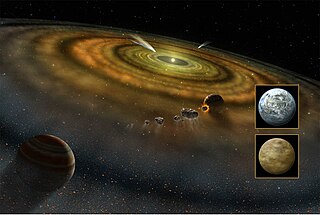
An exocomet, or extrasolar comet, is a comet outside the Solar System, which includes rogue comets and comets that orbit stars other than the Sun. The first exocomets were detected in 1987 around Beta Pictoris, a very young A-type main-sequence star. There are now a total of 27 stars around which exocomets have been observed or suspected.
In combinatorial mathematics, the hook length formula is a formula for the number of standard Young tableaux whose shape is a given Young diagram. It has applications in diverse areas such as representation theory, probability, and algorithm analysis; for example, the problem of longest increasing subsequences. A related formula gives the number of semi-standard Young tableaux, which is a specialization of a Schur polynomial.
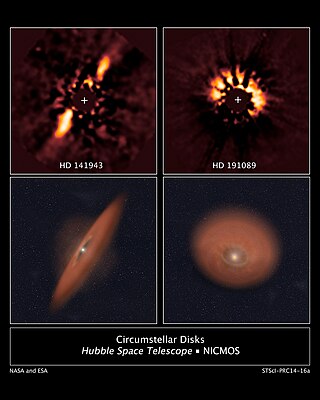
A circumstellar disc is a torus, pancake or ring-shaped accretion disk of matter composed of gas, dust, planetesimals, asteroids, or collision fragments in orbit around a star. Around the youngest stars, they are the reservoirs of material out of which planets may form. Around mature stars, they indicate that planetesimal formation has taken place, and around white dwarfs, they indicate that planetary material survived the whole of stellar evolution. Such a disc can manifest itself in various ways.
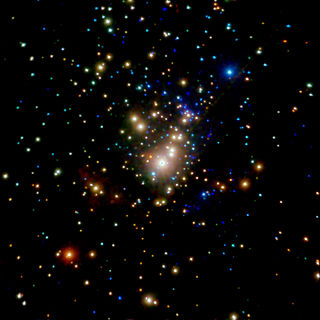
Embedded stellar clusters, or simply embedded clusters (EC), are open clusters that are still surrounded by their progenitor molecular cloud. They are often areas of active star formation, giving rise to stellar objects that have similar ages and compositions. Because of the dense material that surrounds the stars, they appear obscured in visible light but can be observed using other sections of the electromagnetic spectrum, such as the near-infrared and X-rays that can see through the cloud material. In the Milky Way Galaxy, embedded clusters can mostly be found within the Galactic disk or near the Galactic Center where most of the star-formation activity is happening.

BM Andromedae is a T Tauri star in the constellation Andromeda. Its apparent visual magnitude has irregular variations between a maximum of 11.63 and a minimum of 14.02.
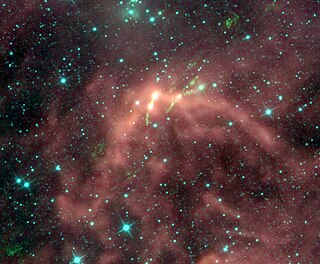
The dark nebula Barnard 203 or Lynds 1448 is located about one degree southwest of NGC 1333 in the Perseus molecular cloud, at a distance of about 800 light-years. Three infrared sources were observed in this region by IRAS, called IRS 1, IRS 2 and IRS 3.
![]() Media related to Young stellar objects at Wikimedia Commons
Media related to Young stellar objects at Wikimedia Commons